Description
Purchase Orders: Click “Add to Cart” button to order, then email PO to orders@altogen.com.
Product Availability: In Stock.
Pancreas In Vivo Transfection Reagent
siRNA and DNA pancreas in vivo delivery reagent for animal research (mouse, rat)
Modes of administration:
- Systemic intravenous (i.v.) injection
- Direct intratumoral (i.t.) injection
- Intraperitoneal (i.p.) injection
Pancreas-targeted In Vivo Transfection Reagent
- Biodegradable lipid liposome-based reagent
- Liposome conjugated complexes are stable in serum (16 hours)
- Efficient delivery to the pancreas tissue (via systemic administration) and pancreas tumors (via intratumoral administration)
- Efficient siRNA, shRNA, microRNA, and plasmid DNA delivery
- Minimal toxicity
- Functionally validated in mice
- Applicable for siRNA and plasmid DNA co-injection
- Download Pancreas-targeted in vivo transfection protocol: [PDF] [Word]
- Download PowerPoint presentation for Pancreas-targeted in vivo transfection kit: [PPT]
- Download safety data sheet: [PDF]
- UPC/GTIN/EAN: 860002089712
-
Brand: ALTOGEN®, developed and manufactured by Altogen Biosystems
DATA
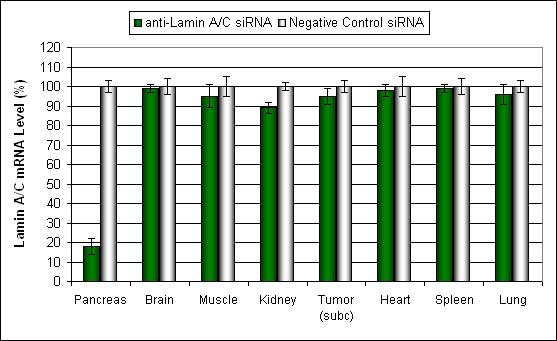
Figure 1. Systemic administration (i.v.) of Pancreas In Vivo Transfection Reagent conjugated with 80 ug of chemically modified siRNA targeting Lamin A/C mRNA or non-silencing control siRNA following the recommended protocol. Tissues (Pancreas, Brain, Muscle, Kidney, Tumor, Heart, Spleen, Lung) were collected and RNA isolated 48 hours after first injection. Samples were analyzed by qRT-PCR for Lamin A/C gene expression levels. Ribosomal RNA levels were used to normalize the Lamin A/C data. Data are means ± SD (n=8).
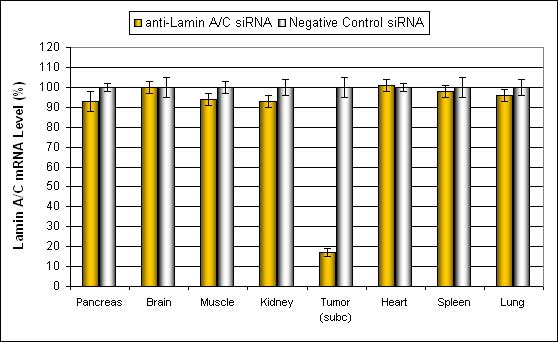
Figure 2. Intratumoral administration (i.t.) of Pancreas In Vivo Transfection Reagent conjugated with 80 ug of chemically modified siRNA targeting Lamin A/C mRNA or non-silencing control siRNA following the recommended protocol. Tissues (Pancreas, Brain, Muscle, Kidney, Tumor, Heart, Spleen, Lung) were collected and RNA isolated 48 hours after first injection. Samples were analyzed by qRT-PCR for Lamin A/C gene expression levels. Ribosomal RNA levels were used to normalize the Lamin A/C data. Data are means ± SD (n=8).
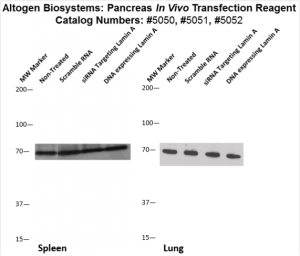
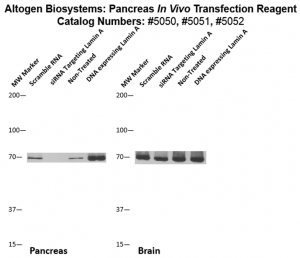
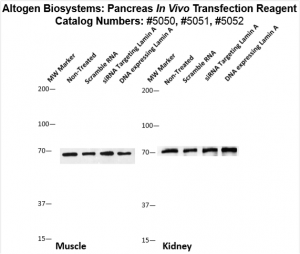
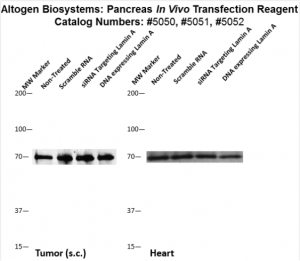
Figure 3. Systemic administration (i.v.) of Pancreas In Vivo Transfection Reagent conjugated with 80 ug of chemically modified siRNA targeting Lamin A/C mRNA or non-silencing control siRNA following the recommended protocol. Tissues (Liver, Brain, Muscle, Kidney, Tumor, Heart, Spleen, Lung) were collected and total protein fraction isolated 72 hours after first injection. Samples were analyzed by Western Blot Analysis for Lamin A/C gene expression levels.
Selected in vivo transfection product citations (ALTOGEN® IN VIVO Transfection Kits used in the following publications):
- Nature. 2008 454(7203):523-7. Innate immunity induced by composition-dependent RIG-I …Saito et al [PDF]
- Am J Pathology. 2010 177(4):1870-80. Role of ocular complement factor H in a murine model … Lyzogubov et al [PDF]
- Nature Biotechnology. 2011 29(4):341-5. Delivery of siRNA to the mouse brain by … Alvarez-Erviti et al [PDF]
- Cancer Research. 2011 71(15):5144-53. Inhibition of miR-193a expression by… Iliopoulos et al [PDF]
- RNA. 2010 16(11):2108-19. RNase L releases a small RNA from HCV RNA that refolds … Malathi et al [PDF]
- Diabetologia. 2012 55(7):2069-79. The p47phox- and NADPH oxidase organiser 1 … Youn et al [PDF]
- British Journal of Cancer. 2012 107(3):516-26. TIGAR induces p53-mediated cell-cycle … Madan et al [PDF]
- Hypertension. 2014 63(2):353-61. Tissue transglutaminase contributes to … Liu et al [PDF]
- Circulation Research. 2010 15;107(8). Kruppel-like factor-4 transcriptionally regulates … Cowan et al [PDF]
- Hypertension. 2012 59(1):158-66. Role of uncoupled endothelial nitric oxide synthase … Gao et al [PDF]
- Jounal of Biological Chemistry. 2012 287(4):2907. Chaperoning of mutant p53 protein … Gogna et al [PDF]
- PLoS Pathogens. 2012 8(8) Uridine composition of the poly-U/UC tract of HCV RNA … Schnell et al [PDF]
- J Proteome Res. 2012(11) Retinal proteome analysis in a mouse model of oxygen-induced … Kim et al [PDF]
- J Transl Med. 2010 15;8:133. Prevention of hyperglycemia-induced myocardial apoptosis … Zhang et al [PDF]
- Mol Cell Biol. 2013 33(7). SCO2 induces p53-mediated apoptosis by Thr845 phosphorylation … Madan et al [PDF]
- Hypertension. 2015 65(2):430-9. Neurokinin 3 receptor and phosphocholine transferase… Parchim et al [PDF]
- Gastroenterology. 2011 141(2) Differential type I interferon-mediated autophagic trafficking … Desai et al [PDF]
- PLoS Pathog. 2014 10(10) Exosomes from hepatitis C infected patients transmit HCV … Bukong et al [PDF]
Pancreas-targeted in vivo transfection
Targeted drug delivery in pancreatic cancer involves the delivery of therapeutic agents specifically to cancer cells in the pancreas, while minimizing side effects in healthy tissues. This approach can improve the efficacy of cancer treatment and reduce the toxicity associated with traditional chemotherapy. One approach to targeted drug delivery is the use of nanoparticles, which can be engineered to selectively accumulate in tumor tissue. For example, nanoparticles can be coated with ligands that specifically bind to receptors on the surface of pancreatic cancer cells, allowing for targeted delivery of the drug payload. Additionally, nanoparticles can be designed to release their drug payload in response to specific stimuli, such as low pH or the presence of enzymes that are abundant in the tumor microenvironment. Another approach to targeted drug delivery in pancreatic cancer is the use of antibody-drug conjugates (ADCs), which combine the targeting ability of antibodies with the cytotoxicity of chemotherapy drugs. ADCs consist of an antibody that targets a specific antigen on the surface of cancer cells, linked to a cytotoxic drug. When the ADC binds to the cancer cell, the drug is released and induces cell death. Additionally, researchers are investigating the use of gene therapy for targeted drug delivery in pancreatic cancer. This approach involves the delivery of genetic material, such as small interfering RNA (siRNA), to inhibit the expression of genes that contribute to tumor growth and progression. Targeted drug delivery in pancreatic cancer is an active area of research, and ongoing studies are focused on developing more effective and specific delivery systems to improve the treatment of this challenging disease.
Altogen Research Services:
Altogen Labs provides GLP compliant contract research studies for preclinical drug development, efficacy and safety studies for IND applications. Biology CRO services includes: Xenograft models (90+), development of stable cell lines, ELISA assay development, cell-based and tissue targeted RNAi studies, safety pharm/tox assays, and many other types of R&D studies (visit AltogenLabs.com).
Volume Options:
- 0.5 ml – 10 injections (Catalog #5050)
- 1.5 ml – 30 injections (Catalog #5051)
- 8.0 ml – 160 injections (Catalog #5052)
- 25 ml – 50 rat injections or 500 mouse injections (Catalog #5053)
Purchase Orders: Click “Add to Cart” button to order, then email PO to orders@altogen.com.
Product Availability: In Stock.





